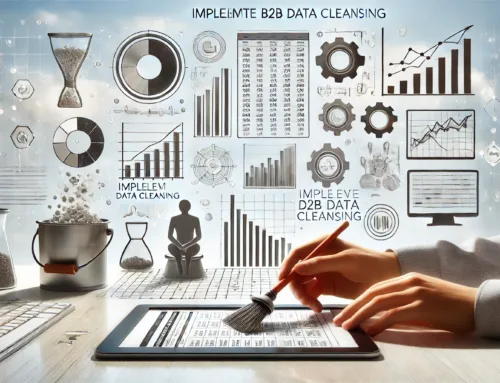To ensure quality in B2B data cleansing, you must establish clear quality standards and proactively address any issues that may compromise the accuracy of your database. By implementing robust data profiling and enrichment tools, you can enhance the overall health of your data repository. Correcting errors, standardizing entries, and regularly validating your data are crucial steps in maintaining data accuracy. However, there is one often-overlooked aspect that can significantly impact the quality of your data cleansing efforts – a factor that can make or break the success of your data management strategy.
Define Quality Standards
Defining quality standards is a crucial step in the process of B2B data cleansing. To ensure data accuracy, it is essential to establish clear criteria for what constitutes accurate data within your organization. Accuracy involves data being correct and free from errors, ensuring that decisions made based on this data are reliable. Additionally, data completeness plays a vital role in maintaining quality standards. Complete data contains all the necessary information required for its intended use, avoiding gaps or missing pieces that could lead to misinformation.
Identify Quality Issues
Identifying quality issues is a critical aspect of B2B data cleansing. To effectively identify quality issues, start by conducting data profiling to gain insights into the overall health of your database. Data profiling involves analyzing the content, structure, and relationships within your data to uncover inconsistencies, inaccuracies, or gaps. This process helps in understanding the current state of your data quality and pinpointing areas that require improvement.
Additionally, utilizing data enrichment tools can aid in identifying quality issues by enhancing the existing data with additional information from reliable sources. Data enrichment can fill in missing details, standardize formats, and validate existing data for accuracy. By enriching your data, you can identify any discrepancies or inconsistencies that may exist within your database.
Correct Erroneous Data
To rectify erroneous data within your B2B database, commence by conducting a thorough assessment of the identified inaccuracies. Begin by updating records with the correct information and eliminating any duplicates present. Scrutinize each data point meticulously to ensure accuracy. Look for inconsistencies in names, addresses, contact numbers, and any other pertinent details. When updating records, make sure to cross-verify the information from reliable sources to guarantee its correctness.
Eliminating duplicates is crucial to maintaining a clean and efficient database. Use automated tools or manual checks to identify and remove duplicate entries. This process not only enhances data accuracy but also improves the overall efficiency of your database management. By streamlining the data and ensuring that each entry is unique, you reduce the risk of errors and redundancies in your B2B database.
Regularly revisiting and updating your data cleansing processes will help in keeping your database accurate and up-to-date, ultimately contributing to better decision-making and more effective marketing strategies.
Standardize Data Entries
Standardizing data entries is a fundamental aspect of ensuring data accuracy and consistency within your B2B database. Data normalization plays a crucial role in standardizing data entries by organizing information into a uniform format. This process involves removing any inconsistencies in how data is represented, such as date formats or address variations, to maintain a clean and structured database.
In addition to data normalization, data validation is essential in standardizing data entries. By implementing validation rules, you can ensure that only accurate and reliable information is entered into your database. This helps prevent errors and inconsistencies that can arise from inaccurate data entries.
Furthermore, standardizing data entries aids in duplicate detection and data enrichment. By establishing consistent data entry guidelines, you can easily identify and eliminate duplicate records, ensuring data integrity and improving the overall quality of your database. Additionally, standardized data entries facilitate data enrichment efforts by making it easier to append additional information to existing records accurately.
Validate Data Regularly
Regularly validating your data is a critical practice in maintaining the accuracy and reliability of your B2B database. Data accuracy is essential for making informed business decisions, targeting the right audience, and ensuring successful marketing campaigns. By conducting regular audits of your data, you can identify and rectify any inconsistencies, errors, or duplications that may have crept in over time.
Regular validation helps in ensuring that your database remains up-to-date and reflective of the current state of your business relationships. It also aids in improving the overall efficiency of your marketing and sales efforts by providing you with clean and reliable data to work with. Through regular audits, you can verify the correctness of contact information, update any changes promptly, and eliminate outdated or irrelevant entries. This proactive approach not only enhances data accuracy but also saves time and resources that might have otherwise been wasted on targeting incorrect or outdated leads.
Frequently Asked Questions
How Can Data Cleansing Improve Overall Business Performance?
To improve overall business performance, data cleansing boosts data accuracy, enhancing decision making and business efficiency. It reduces errors, leading to cost savings by streamlining operations. Ensuring clean data empowers you to make informed choices, driving success.
What Are the Common Challenges Faced During Data Cleansing?
During data cleansing, you may encounter challenges with data accuracy and completeness. It’s crucial to validate information sources, standardize formats, and deduplicate records. Implementing automated tools can streamline the process and ensure high-quality data for informed decision-making.
Is There a Way to Automate the Data Cleansing Process?
Looking to streamline your data cleansing tasks? Can automating processes ensure data accuracy? Yes! By implementing automated tools and algorithms, you can expedite the cleansing process, reduce errors, and enhance the overall quality of your B2B data.
How Does Data Cleansing Impact Regulatory Compliance?
Data cleansing is pivotal for data accuracy. It ensures compliance with regulatory standards by identifying inconsistencies and errors. A meticulous approach in the process is necessary to uphold compliance, safeguarding against risks and maintaining data integrity.
What Are the Best Practices for Maintaining Data Quality Post-Cleansing?
After cleansing data, focus on data validation to ensure accuracy. Implement continuous monitoring to catch errors promptly. These practices maintain data quality effectively. Stay vigilant and proactive in managing your data to uphold its integrity in the long run.




